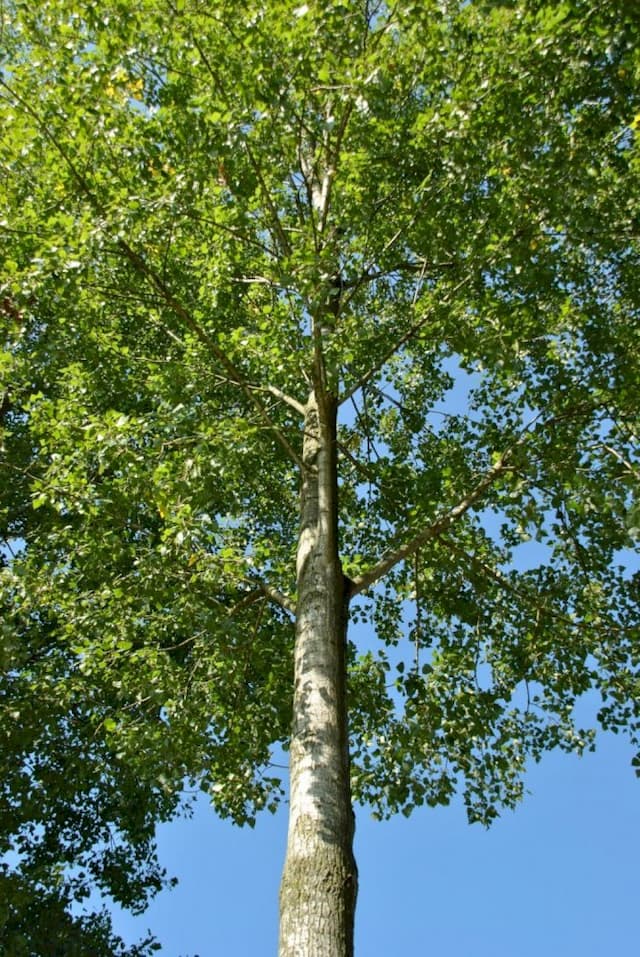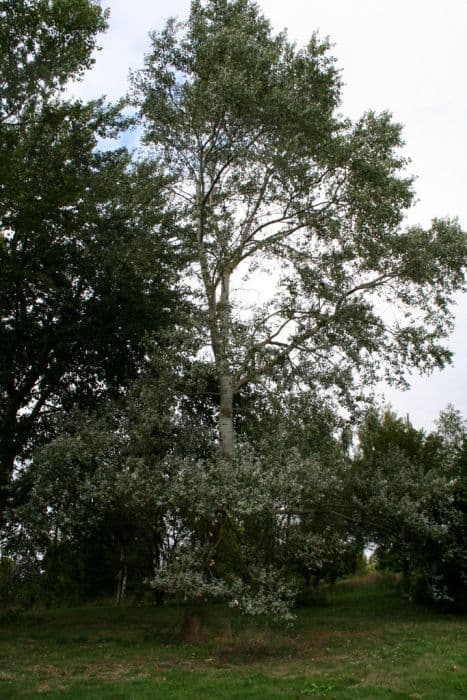Aurora Balsam Poplar Populus × jackii 'Aurora' (f/v)

ABOUT
The plant known as the 'Aurora' is a type of hybrid poplar with a distinctive appearance. It presents a combination of vibrant green leaves that have a unique variegation with its edges commonly streaked in creamy white and hues of pale green. This variegation can be quite eye-catching, with the contrast of colors being most pronounced on the upper surfaces of the leaves, while the undersides may show a more subdued coloration. In spring and early summer, the foliage is especially attractive as the new growth emerges, creating a fresh and lively visual interest. The leaves are typically broad and somewhat triangular in silhouette, with a pointed tip and rounded base, resembling the classic heart or spade shape often associated with poplar trees. As the seasons change, the 'Aurora' maintains its decorative look, but the intensity of the variegation can be subject to fluctuating temperatures and sunlight exposure, making each specimen somewhat unique in its patterning. This deciduous tree bears its leaves on branches that spread outwards, creating an inviting canopy that can be quite lush during the peak growing months. Though not specifically discussing its size, it's worth noting that the overall form of the 'Aurora' presents an elegant and upright growth habit, with a branching structure that lends itself to a pleasing, somewhat pyramidal or rounded shape. The plant also produces catkins, which are long, pendulous clusters that add an additional texture to the tree's appearance. These can be observed in late spring or early summer, depending on the region and climate. Throughout the year, the 'Aurora' provides a dynamic visual display, with its ornamental leaves and distinctive variegation bringing a captivating aesthetic to any landscape in which it's planted, sans mentioning its dimensions.
About this plant
 Names
NamesFamily
Salicaceae
Synonyms
Balm Of Gilead, Aurora Balsam Poplar, Jack's Poplar
Common names
Populus × jackii 'Aurora'
 Toxicity
ToxicityTo humans
The plant commonly known as the Balm of Gilead (Populus × jackii 'Aurora') is not typically regarded as poisonous to humans. However, some people may experience allergic reactions when coming into contact with the sap of the tree, which can cause skin irritation. If ingested, parts of the tree are not generally considered toxic, though it is not advised to consume any part of ornamental trees. There have been no well-documented cases of poisoning from ingesting Balm of Gilead in humans.
To pets
The Balm of Gilead (Populus × jackii 'Aurora') is also not specifically listed as toxic to pets. While the ingestion of non-food plants can sometimes lead to gastrointestinal upset in pets such as vomiting and diarrhea, Balm of Gilead is not recognized for having toxic effects. However, as with humans, the tree's sap can cause allergic reactions or irritation upon skin contact in some pets. If a pet were to ingest a large quantity of any non-food plant, including this one, it is prudent to monitor for signs of gastrointestinal distress and consult a veterinarian.
 Characteristics
CharacteristicsLife cycle
Perennials
Foliage type
Deciduous
Color of leaves
Green
Height
40-50 feet (12-15 meters)
Spread
30-40 feet (9-12 meters)
Plant type
Tree
Hardiness zones
3
Native area
North America
Benefits
 General Benefits
General Benefits- Ornamental Value: Populus × jackii 'Aurora' is often planted for its attractive foliage and bark, enhancing the aesthetic appeal of gardens and landscapes.
- Shade Provision: With its broad canopy, it offers ample shade in outdoor spaces, making it suitable for parks and large gardens.
- Habitat Creation: The tree provides a habitat for various species of birds and other wildlife, contributing to biodiversity.
- Windbreak: It can serve as an effective windbreak, protecting against soil erosion and offering shelter for other plants.
- Sound Barrier: The tree can help reduce noise when planted in rows, beneficial near roads or industrial areas.
 Medical Properties
Medical PropertiesThis plant is not used for medical purposes.
 Air-purifying Qualities
Air-purifying QualitiesThis plant is not specifically known for air purifying qualities.
 Other Uses
Other Uses- Artistic Inspiration: Populus × jackii 'Aurora', commonly known as Balsam Poplar, can be used by artists as a subject for photography, painting, and drawing due to its striking variegated foliage.
- Education and Research: Balsam Poplar can serve as a living model in botanical and horticultural studies, offering students and scientists a chance to observe hybrid vigor and plant adaptations.
- Habitat Creation: This tree provides a microhabitat for insects and birds, offering nesting sites and shelter within its boughs.
- Soundscape Enhancement: The leaves of Balsam Poplar create a soothing rustling sound in the breeze, which can be intentionally utilized in landscape designs to enhance the auditory experience of a garden or park.
- Crafts: Dried leaves and small branches from the Balsam Poplar can be used in crafting, such as in wreath making or as natural elements in decorative arrangements.
- Event Decor: Live branches or cuttings from the Balsam Poplar can be creatively used as part of floral displays or decorative themes for weddings and other events, adding a touch of natural beauty.
- Dye Source: The leaves and bark of Balsam Poplar may be used to produce natural dyes for textiles or artwork, offering a sustainable source of pigments.
- Symbolism: Due to its resilience and growth habits, Balsam Poplar can be used symbolically in literature or as part of cultural ceremonies representing strength and renewal.
- Shade Provider: In outdoor spaces such as playgrounds or picnic areas, Balsam Poplar's broad canopy can provide natural shade, creating a cooler environment during sunny days.
- Windbreaks: When planted in rows or groups, the Balsam Poplar can act as a windbreak, protecting smaller plants and reducing wind erosion in gardens and on farms.
Interesting Facts
 Feng Shui
Feng ShuiThe Balm of Gilead is not used in Feng Shui practice.
 Zodiac Sign Compitability
Zodiac Sign CompitabilityThe Balm of Gilead is not used in astrology practice.
 Plant Symbolism
Plant Symbolism- Resilience and Adaptability: Balsam Poplar hybrids like Populus × jackii 'Aurora' are known for their hardiness and ability to thrive in adverse conditions, symbolizing one's resilience and adaptability in life.
- Growth and Renewal: As a fast-growing tree, Balsam Poplar signifies rapid growth and the continual renewal of life, representing personal development and the idea of new beginnings.
- Protection: In some cultures, poplar trees have been associated with protection due to their height and presence. This extends to the symbolism of offering shelter and safety.
- Communication: The rustling leaves of Balsam Poplar are often associated with communication and the tree’s capability to bring messages through the wind, symbolizing the importance of conveying thoughts and ideas.
 Water
WaterBalsam Poplar trees require consistent moisture, especially in their young and developmental stages. They should be watered deeply about once a week, providing around 1 to 2 inches of water which can be equivalent to approximately 15-30 gallons for a young tree, depending on its size and the weather conditions. During hot, dry periods, waterings may need to be increased to twice a week. It is important to avoid waterlogging, so ensuring proper drainage is essential. Mulching can help maintain soil moisture and reduce the frequency of watering.
 Light
LightBalsam Poplar trees thrive in full sunlight, where they can receive at least 6 hours of direct sunlight daily. The best spot for planting a Balsam Poplar is in an open space, away from buildings or other trees that might cast shade on it. Avoid planting in heavily shaded areas as this can hinder its growth and overall health.
 Temperature
TemperatureBalsam Poplars are hardy and can survive in temperatures as low as -40 degrees Fahrenheit and as high as 100 degrees Fahrenheit. However, the ideal temperature range for this tree is between 50 to 75 degrees Fahrenheit. They are best suited for planting in USDA hardiness zones 2 to 9 and can withstand significant temperature fluctuations.
 Pruning
PruningBalsam Poplar trees should be pruned to maintain shape and promote healthy growth, removing any broken or diseased branches as needed. The best time to prune is during the dormant season, late winter to early spring, before new growth starts. Prune every 3 to 5 years to give the tree a chance to fill out naturally and to minimize stress from cutting.
 Cleaning
CleaningAs needed
 Soil
SoilThe Balm of Gilead prefers a well-drained, loamy soil rich in organic matter with a pH range of 6.0 to 7.5. A balanced mix of sandy loam, peat, and compost works well, promoting good root growth and drainage.
 Repotting
RepottingBeing a large and fast-growing tree, the Balm of Gilead rarely needs repotting as it is primarily planted outdoors. Instead, it requires ample space to grow and may be transplanted to suit landscape changes.
 Humidity & Misting
Humidity & MistingThe Balm of Gilead thrives in moderate to high humidity levels typical of its natural habitat, although it is adaptable to various humidity conditions when grown outdoors.
 Suitable locations
Suitable locationsIndoor
Prefers not being grown indoors due to size.
Outdoor
Ensure full sun and ample space for growth.
Hardiness zone
3-9 USDA
 Life cycle
Life cycleThe common name for Populus × jackii 'Aurora' is Balm of Gilead. Its life cycle begins with seed germination, where the tiny seeds, often dispersed by wind due to their light and fluffy nature, land in fertile, moist soil and begin to sprout. These seedlings quickly develop into young saplings, showing rapid growth characteristic of the genus Populus. As saplings mature into adult trees, they may reach substantial heights and are characterized by their straight trunks and spreading branches. During spring, Balm of Gilead produces catkins, which are the flowering structures necessary for pollination and subsequent seed production. As they age, the trees eventually reach the senescence stage, where growth slows and they become susceptible to environmental stresses, pests, and diseases, leading to their eventual decline and death.
 Propogation
PropogationPropogation time
Spring-Early Summer
The Populus × jackii 'Aurora', commonly known as the Aurora Balsam Poplar, is most effectively propagated through hardwood cuttings. The best time to take these cuttings is in late winter when the tree is dormant, generally from January to March. To make a cutting, select a healthy, disease-free branch and snip a 6 to 8-inch (approximately 15 to 20 centimeters) length. The cutting should have at least a couple of nodes where leaves attach as these are potential growth points. The base of the cutting is then dipped in rooting hormone to encourage root development and planted in a well-draining soil mix. It’s crucial to keep the soil moist but not waterlogged to prevent the cutting from rotting. Under the right conditions, roots will begin to form in a few weeks, and the new plant can eventually be transplanted outdoors.









